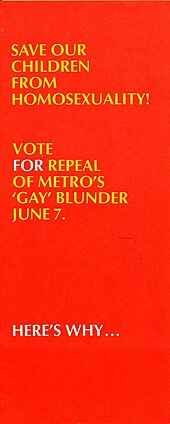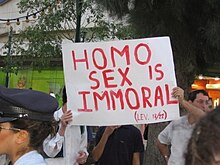
A | B | C | D | E | F | G | H | CH | I | J | K | L | M | N | O | P | Q | R | S | T | U | V | W | X | Y | Z | 0 | 1 | 2 | 3 | 4 | 5 | 6 | 7 | 8 | 9
| Part of a series on |
| Discrimination |
|---|
 |
| Part of a series on |
| LGBT topics |
|---|
|
|
Homophobia encompasses a range of negative attitudes and feelings toward homosexuality or people who identify or are perceived as being lesbian, gay or bisexual.[2][3][4] It has been defined as contempt, prejudice, aversion, hatred or antipathy, may be based on irrational fear and may sometimes be attributed to religious beliefs.[5][6]
Homophobia is observable in critical and hostile behavior such as discrimination and violence on the basis of sexual orientations that are non-heterosexual.[2][3][7] Recognized types of homophobia include institutionalized homophobia, e.g. religious homophobia and state-sponsored homophobia, and internalized homophobia, experienced by people who have same-sex attractions, regardless of how they identify.[8][9]
Negative attitudes toward identifiable LGBT groups have similar yet specific names: lesbophobia is the intersection of homophobia and sexism directed against lesbians, gayphobia is the dislike or hatred of gay men, biphobia targets bisexuality and bisexual people, and transphobia targets transgender and transsexual people and gender variance or gender role nonconformity.[10][2][4][11] According to 2010 Hate Crimes Statistics released by the FBI National Press Office, 19.3 percent of hate crimes across the United States "were motivated by a sexual orientation bias."[12] Moreover, in a Southern Poverty Law Center 2010 Intelligence Report extrapolating data from FBI national hate crime statistics from 1995 to 2008, found that LGBT people were "far more likely than any other minority group in the United States to be victimized by violent hate crime."[13]
Etymology
Although sexual attitudes tracing back to Ancient Greece – from the 8th to 6th centuries BC to the end of antiquity (c. 600 AD) – have been termed homophobia by scholars, and it is used to describe an intolerance towards homosexuality and homosexuals that grew during the Middle Ages, especially by adherents of Islam and Christianity,[14] the term itself is relatively new.[15]
Coined by George Weinberg, a psychologist, in the 1960s,[16] the term homophobia is a blend of (1) the word homosexual, itself a mix of neo-classical morphemes, and (2) phobia from the Greek φόβος, phóbos, meaning "fear", "morbid fear" or "aversion".[17][18][19] Weinberg is credited as the first person to have used the term in speech.[15] The word homophobia first appeared in print in an article written for the May 23, 1969, edition of the American pornographic magazine Screw, in which the word was used to refer to heterosexual men's fear that others might think they are gay.[15]
Conceptualizing anti-LGBT prejudice as a social problem worthy of scholarly attention was not new. A 1969 article in Time described examples of negative attitudes toward homosexuality as "homophobia", including "a mixture of revulsion and apprehension" which some called homosexual panic.[20] In 1971, Kenneth Smith used homophobia as a personality profile to describe the psychological aversion to homosexuality.[21] Weinberg also used it this way in his 1972 book Society and the Healthy Homosexual,[22] published one year before the American Psychiatric Association voted to remove homosexuality from its list of mental disorders.[23][24] Weinberg's term became an important tool for gay and lesbian activists, advocates, and their allies.[15] He describes the concept as a medical phobia:[22]
phobia about homosexuals.... It was a fear of homosexuals which seemed to be associated with a fear of contagion, a fear of reducing the things one fought for — home and family. It was a religious fear and it had led to great brutality as fear always does.[15]
In 1981, homophobia was used for the first time in The Times (of London) to report that the General Synod of the Church of England voted to refuse to condemn homosexuality.[25]
However, when taken literally, homophobia may be a problematic term. Professor David A. F. Haaga says that contemporary usage includes "a wide range of negative emotions, attitudes and behaviours toward homosexual people," which are characteristics that are not consistent with accepted definitions of phobias, that of "an intense, illogical, or abnormal fear of a specified thing."[26]
Types

Homophobia manifests in different forms, and a number of different types have been postulated, among which are internalized homophobia, social homophobia, emotional homophobia, rationalized homophobia, and others.[27] There were also ideas to classify homophobia and other types of bigotry as intolerant personality disorder.[28]
In 1992, the American Psychiatric Association, recognizing the power of the stigma against homosexuality, issued the following statement, reaffirmed by the Board of Trustees, July 2011:[29]
Whereas homosexuality per se implies no impairment in judgment, stability, reliability, or general social or vocational capabilities, the American Psychiatric Association (APA) calls on all international health organizations, psychiatric organizations, and individual psychiatrists in other countries to urge the repeal in their own countries of legislation that penalizes homosexual acts by consenting adults in private. Further, APA calls on these organizations and individuals to do all that is possible to decrease the stigma related to homosexuality wherever and whenever it may occur.
Institutional
Religious attitudes

Text je dostupný za podmienok Creative Commons Attribution/Share-Alike License 3.0 Unported; prípadne za ďalších podmienok. Podrobnejšie informácie nájdete na stránke Podmienky použitia.
Antropológia
Aplikované vedy
Bibliometria
Dejiny vedy
Encyklopédie
Filozofia vedy
Forenzné vedy
Humanitné vedy
Knižničná veda
Kryogenika
Kryptológia
Kulturológia
Literárna veda
Medzidisciplinárne oblasti
Metódy kvantitatívnej analýzy
Metavedy
Metodika
Text je dostupný za podmienok Creative
Commons Attribution/Share-Alike License 3.0 Unported; prípadne za ďalších
podmienok.
Podrobnejšie informácie nájdete na stránke Podmienky
použitia.
www.astronomia.sk | www.biologia.sk | www.botanika.sk | www.dejiny.sk | www.economy.sk | www.elektrotechnika.sk | www.estetika.sk | www.farmakologia.sk | www.filozofia.sk | Fyzika | www.futurologia.sk | www.genetika.sk | www.chemia.sk | www.lingvistika.sk | www.politologia.sk | www.psychologia.sk | www.sexuologia.sk | www.sociologia.sk | www.veda.sk I www.zoologia.sk
